Media Me and We
By Shanna Griffus-Martinez and Carrie Seavoy
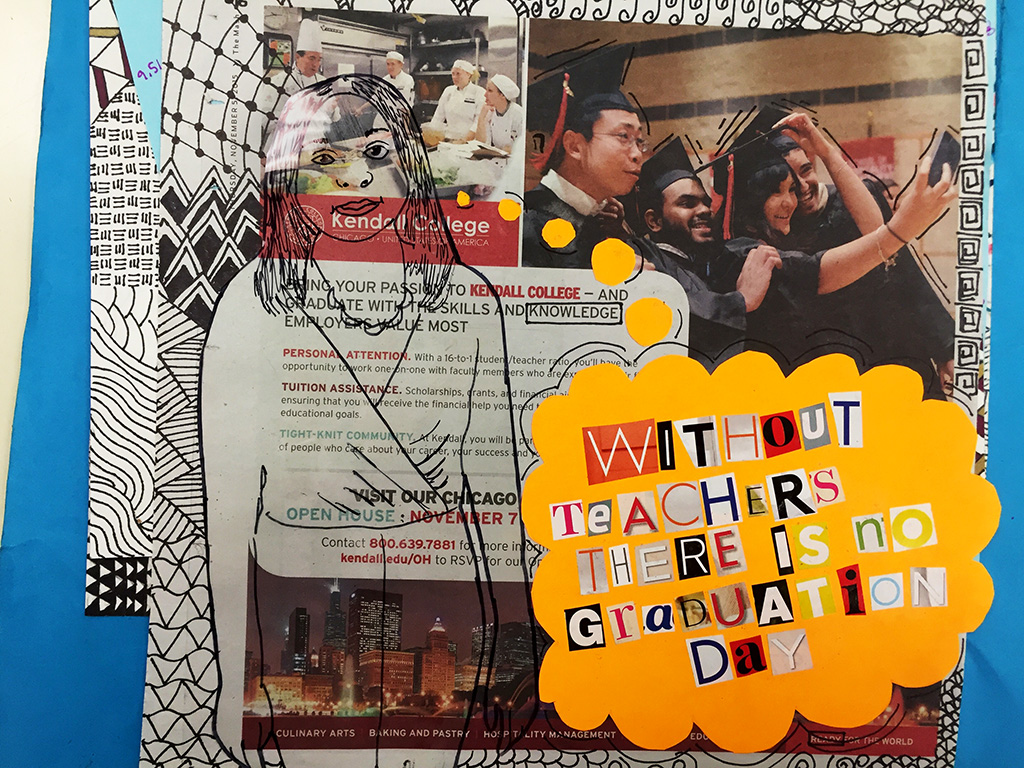
Both Mixed Media (Visual Arts) and Beginning Choir (Performing Arts) students at our school were given a set of criteria to prompt them to create a participatory, socially engaged art project. The criteria stated that the project should: make connections to contemporary art, respond to issues of importance within a community, engage in a critical dialogue, extend beyond the classroom, and document the process or artwork. Students filled out proposal forms independently or within groups, describing projects that they wanted to complete and materials they would need to be successful in their projects. Projects and procedures varied slightly between the music and art classes, but in the end students performed, displayed, recorded, collected, and shared their projects of choice with the school and community.
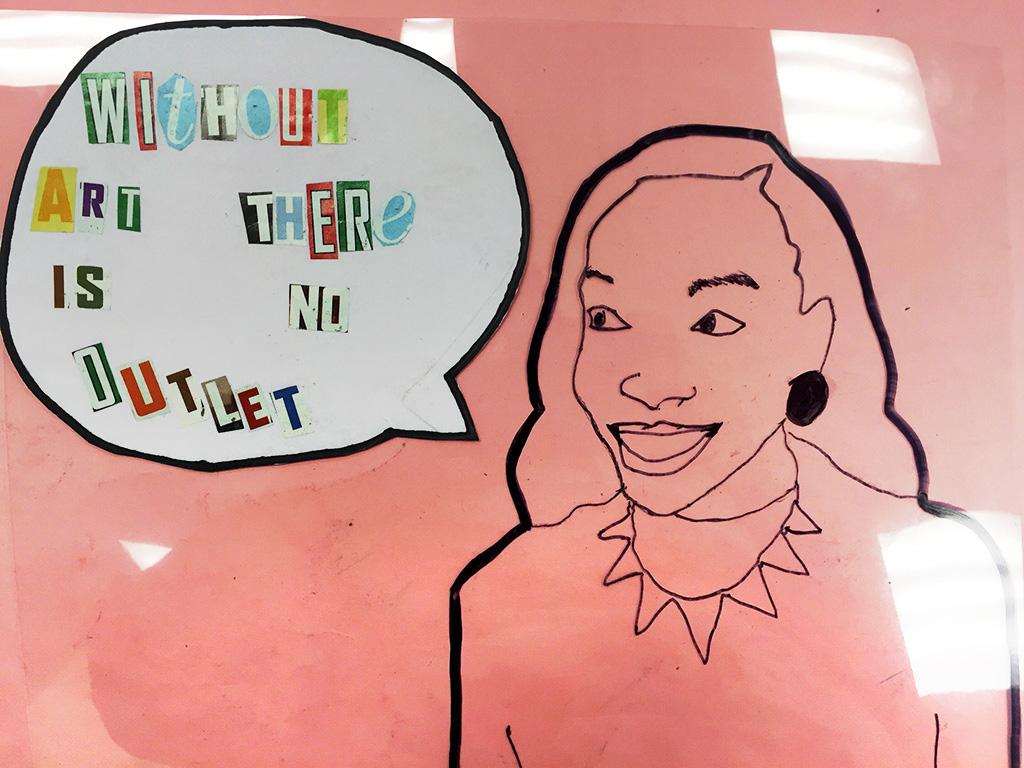
Goals + Objectives
- Students will use art, music, and engagement with their community to convey a message about media and image.
- Students will experience the power that the arts have for creating social change
- Students will be able to create their own proposal for an art project.
- Students will be able to work collaboratively to execute a group participatory art project.
Guiding Questions
- How does the media portray you?
- How does this media portrayal impact you?
- How do artists make meaningful connections to creating, performing, and responding?
- How do visual and performing artists make an impact on the world around them?
- Where do the arts fit into social justice movements?
- What are some ways that artists can make simple decisions to push boundaries in their artwork?
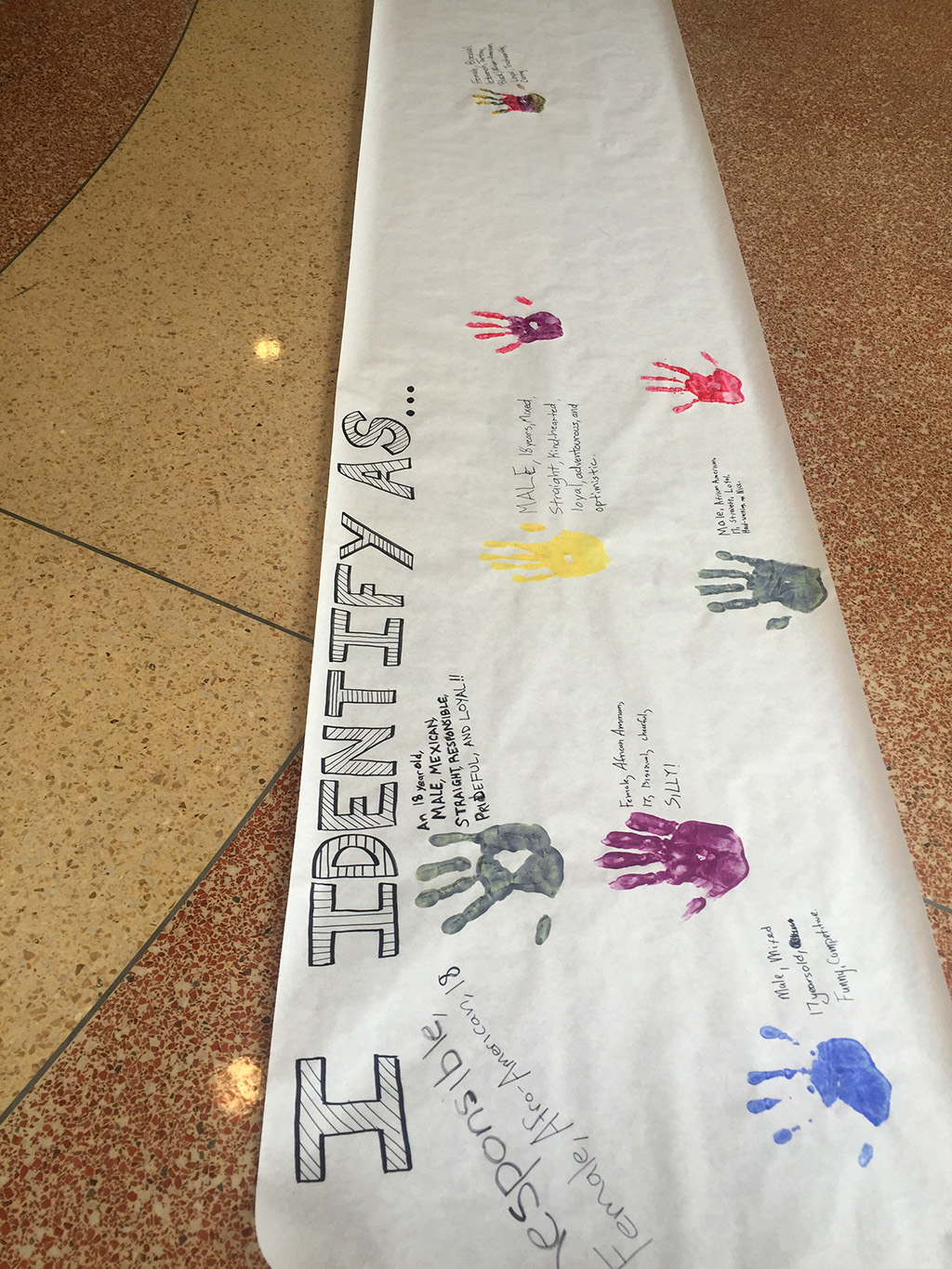
Documentation + Assessment
- Throughout the process, students took photos to record their process and were required to submit these photos throughout the duration of the project. All photos and videos were collected in a Google Classroom assignment. Students were creative with their documentation, which included several Twitter hashtags.
- Students were required to give an in-class reflection by explaining to the rest of the group (1)
what they did, (2) how it went, (3) how people reacted, and (4) what they learned in the process.
Timeframe + Learning Activities
Timeframe
Day 1. Intro to participatory art and socially engaged art.
Day 2. Think, plan, and propose projects.
Day 3. Present in class.
Day 4. Work in groups.
Day 5. Execution.
Day 6. In-class reflection with documentation, presentation, critique, and evaluations.
This timeframe can vary greatly depending on what students propose. Many days could be split into multiple days.
Learning Activities
Day 1. On day 1 in both the Mixed Media and Choir classes, we began with a privilege walk and subtle prejudice activity. Teachers should be sensitive to student privacy when completing this activity. These activities help students to think about privilege and social justice and also are an example of participatory art. Students were then asked to think of 3 words that they used to identify themselves, and then come up with both a positive and negative word associated with each of the 3 words. We had a discussion about these different categories and adjectives, and about where stereotypes came from. This conversation led to a consensus that the media (print, visual, music, advertisements, tv, movies, etc.) contributes greatly to the creation and proliferation of stereotypes. After introducing the project criteria and showing the proposal form, we then talked about what participatory art is by looking at videos and artists.
Day 2. After passing out the “Media, Me, and We” proposal sheet, students in Choir class spent a large chunk of time planning these projects individually. In the Mixed Media class, students determined if they were going to work by themselves or with a group, and then proposed a project. Each student or group had to turn in a proposal at the end of the class.
Day 3. In Choir, each person came up to the front of the room and gave a 90-second “elevator pitch” (just enough to get people excited—not all of the details) of their idea. We narrowed down the total number of project proposals (we went from >50 projects down to 8 that were the top-voted ideas), and students joined the group that they were most excited about working with, based on the elevator pitch. Students were allowed to choose their groups by ballot to avoid hurt feelings. In Multimedia, students formed groups, and each group or individual student chose a project and conferenced with the teacher to make sure the criteria were met. Both ways of going about the project met our goal.
Day 4–5(+). These were strict work days where the groups made their plans and began to execute them. Students wrote a schedule to establish a timeline for their projects. They were given a due date and had to fill out a day-by-day schedule for what they would do on their projects until that due date. Depending on the extent of the project, the timeline could expand to about 3-5 days. We had a few projects that were not done by the time we had our end-of-class presentations, but they were still motivated to finish their projects, even after the presentations, because they were excited about their ideas and took ownership of the projects. Projects that were proposed in our classes were varied and covered topics from bullying to child trafficking, to the support of students at Mizzou, to the media’s portrayal of Chicago. They used Twitter, videos, photography, sculpture, songs, a rally, a “blackout” clothing day, and many other forms of media to portray their messages and encourage others to participate in the conversation.
In Mixed Media class, some of the students worked on projects primarily outside of class (filming videos outside of school, etc.) and had the option of working on an alternate project for extra credit during class time. This project was based on a discussion about the teacher layoffs and budget cuts currently happening in Chicago Public Schools. Students were asked to make a statement about education and their knowledge of the issues, filling in the missing words in this statement: “Without [---] there is no [---].” These projects included an acetate drawing of their self-portrait, recycled books, and collage. These were hung in the school to advocate for funding, teachers, art, and education-related programs.
- Day 6. Last day—All groups gave a 2-minute, in-class presentation about their process and how their project went. Students uploaded their process photos and videos to Google Classroom. The audience evaluated the presentations as they were happening, and discussed the overall experience of creating a socially engaged, choice-based project.
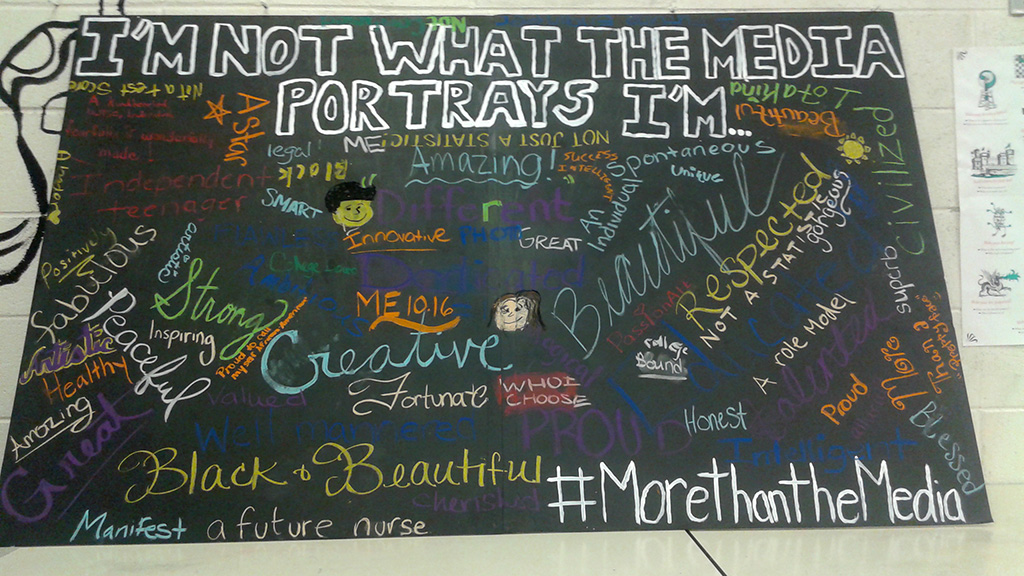
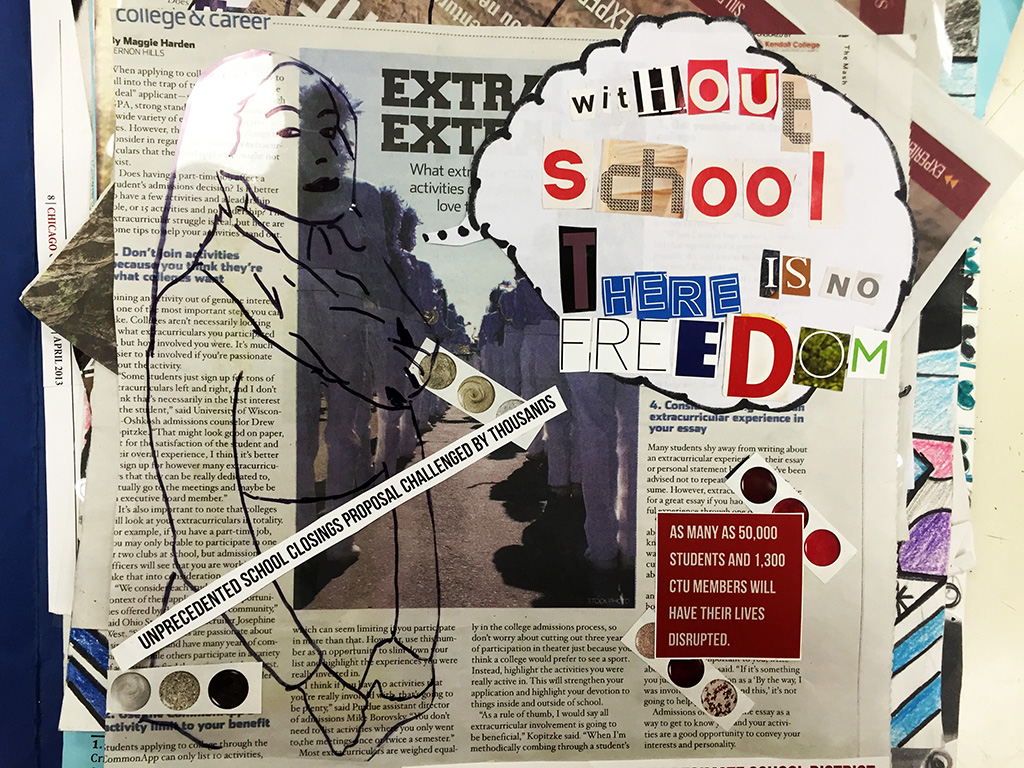
Materials
Materials depended upon the individual project, but included: projector, laptop, poster-boards, markers, stickers, tape, iMovie, Photoshop, chalkboard materials, cameras, printer, drawing and collage materials were all used.
MCA Connections
We connected mainly with the “Me, We” piece by Glenn Ligon (Give Us a Poem) in the Freedom Principle exhibit at the MCA Chicago. This piece alternates flashing the words “Me” and “We.” We used this piece as a jumping-off point to explore the idea of collectivity, as well as to explore the individual as compared to the collective. This piece helped inspire us to work collaboratively as a group.
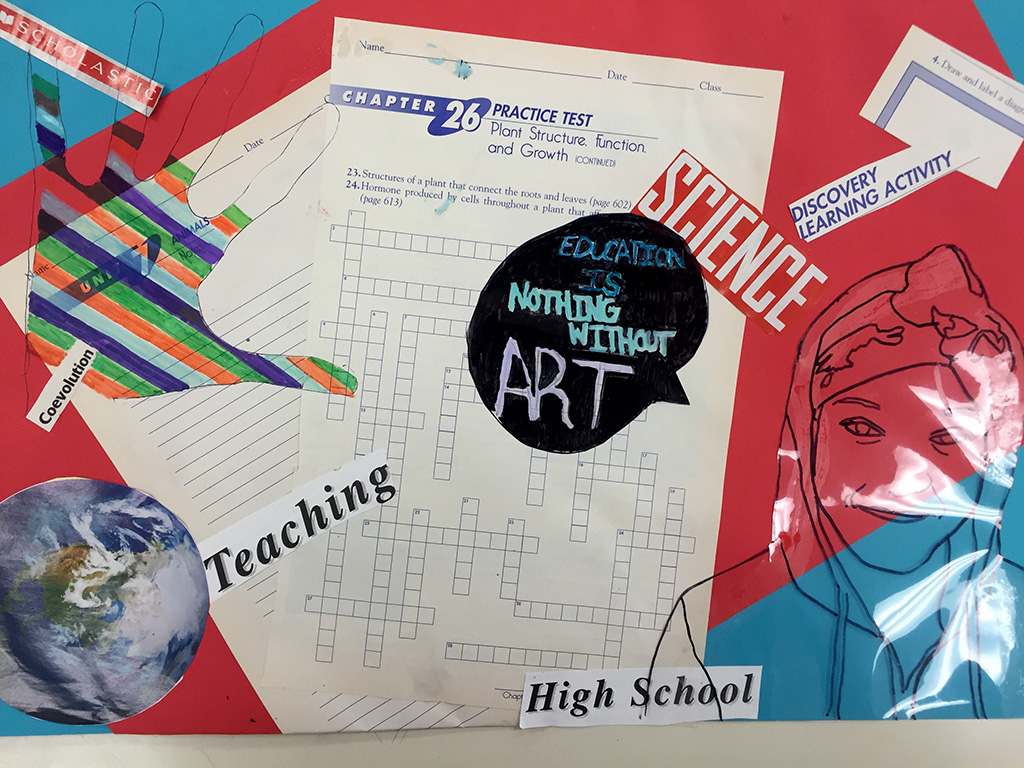
References + Resources
Shanna Griffus-Martinez and Carrie Seavoy
Gwendolyn Brooks College Preparatory Academy
Shanna Martinez is currently in her 4th year of teaching in Chicago Public Schools. Starting off, she created the art program at a South Side grammar school. She is currently starting her second year teaching at Brooks College Prep, a selective enrollment high school in the Pullman/Roseland neighborhood. There she teaches traditional media courses such as Art 1, AP Art, painting, drawing, and sculpture courses. In addition, she is involved with the Asian Culture Club, National Art Honor Society, the Professional Personnel Leadership Committee, the Be Better Cycle team, and Arts Liaison, among others. She received a Bachelor of Fine Arts in Arts Education in 2012 from the School of the Art Institute of Chicago.
Carrie Seavoy is a music teacher at Gwendolyn Brooks College Preparatory Academy. She is a recent alumni of Northwestern University where she studied saxophone performance, music education, psychology, and theatre and arts management. She enjoys yoga, dance, and all things music, theatre, or musical theatre.
Shanna and Carrie reflect on their process:
How does the artwork start an important conversation or try to make a change? How does it go outside of the classroom and even the school community? We introduced socially-engaged art to students through these questions, and they determined how to shape the participatory components. For example, several students made connections to Twitter and posted pictures or hashtags to use their forms of social media to push their projects outside of our classroom. Beyond selecting materials and subject matter, our students were the true leaders, and we were facilitators of their work. In this way, we experienced a new way to run our classroom that revealed new opportunities for more meaningful learning: one of our diverse learners excelled in the choir classroom with his Chicago song. One of our choir/visual arts students lead a Blackout Day for the students being threatened in Mizzou. These were also documented in photos and shared on Twitter. When students needed support using time wisely in the revitalized schedule structure, exit tickets and an alternate project were helpful to keep students organized and engaged during down time.